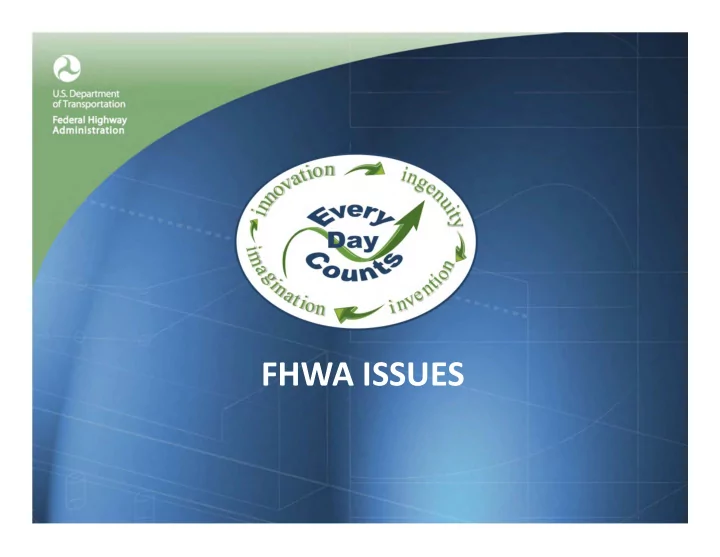

FHWA ISSUES
FHWA Issues • Status of the Trust Fund • Reauthorization • FHWA initiatives – National DBE Program Action Plan – Every Day Counts (EDC)
Status of the Trust Fund
What Happened in 2008???
Status of the Trust Fund • September 2008 – PL 110 ‐ 318 – Transferred $8.017 billion to HTF Highway Account • August 2009 – PL111 ‐ 46 – Transferred $7 billion to HTF Highway Account • March 2010 – HIRE Act – Transfers $14.7 billion to HTF Highway Account. – Extends authority to make expenditures from the HTF through December 31, 2010.
Status of the Trust Fund
Reauthorization • “there’s little consensus on how to pay for everything.” • But there are things being discussed…..
Reauthorization • Things being discussed….. – The need for better partnerships between government and local citizens to set transportation priorities. – More flexibility in how to meet those priorities. – And the need to go from a formula ‐ based approach to one that focuses on outcomes.
Five Key Principals in Reauthorization Framework put forward by DOT Secretary LaHood: – Improving safety and reducing injuries and fatalities; – Keeping our communities economically competitive and accessible to all citizens; – Maintaining the reliability, capacity and efficiency of our entire transportation network; – Creating livable communities where people have more than one choice on how to get from place to place; – And reducing our reliance on oil and cutting greenhouse gas emissions.
Reauthorization • “Don’t look for an early conclusion.”
FHWA Issues • Status of the Trust Fund • Reauthorization • FHWA initiatives – National DBE Program Action Plan – Every Day Counts (EDC)
What is the DBE Program? • The U.S. DOT Disadvantaged Business Enterprise (DBE) program provides a vehicle for increasing the participation by minority and women owned firms in Federal ‐ aid contracting. • A DBE is a for ‐ profit small business that is at least 51 percent owned, controlled and operated by socially and economically disadvantaged persons. – DBE Certification Standards (49 CFR §26):
National DBE Action Plan • The objectives of the DBE Program are: – To ensure that minority and women owned firms can compete fairly for Federal ‐ aid transportation ‐ related projects. – To ensure that only eligible firms participate as DBEs. – To assist DBE firms in competing outside the DBE Program.
National DBE Program Action Plan • Renewed emphasis on program goals • Education and Outreach Efforts to Increase participation • Solicit and hear the issues/barriers to using under utilized firms and a greater minority DBE mix. • Four Major ‐ Project DBE Workforce Development Workshops Planned
FHWA Issues • Status of the Trust Fund • Reauthorization • FHWA initiatives – National DBE Program Action Plan – Every Day Counts (EDC)
Every Day Counts Mission • To identify and deploy readily available innovation and operational changes that will make a difference, incorporating a strong sense of urgency. • To identify policy or operational changes required to advance system innovation in the longer term.
Core Elements Every Day Counts has three core elements • Shortening Project Delivery • Accelerating Technology and Innovation Deployment • Going Greener
Shortening Project Delivery • Accelerating Project Delivery Methods – Design-build – Innovative Contracting Practices • Shortening Project Delivery Toolkit – Planning & Environmental Linkages – Legal Sufficiency Enhancements – Expanding Use of Programmatic Agreements – Expanding Use of In–Lieu Fee and Mitigation Banking – Flexibilities in ROW – Flexibilities in Utility Relocation
Technology & Innovation • Adaptive Signal Control • Geosynthetic Reinforced Soil Integrated Bridge System • Prefabricated Bridge Elements & Systems • Safety Edge • Warm ‐ Mix Asphalt
Technology & Innovation Warm Mix Asphalt Allows a reduction in asphalt mixture production & placement temperatures Benefits: • Provides better compaction • Reduce worker fatigue • Reduces fossil fuel consumption • Reduces CO 2 e & other emissions • Longer paving season • Allows for longer hauling distances • Benefits with High RAP
Technology & Innovation Prefabricated Bridge Elements & Systems Prefabricated bridge elements and systems manufactured on-site or off-site, under controlled conditions, and brought to the job location ready to install Benefits: • Minimizes traffic & community impact • Improves construction zone safety • Improves bridge designs constructability • Increases quality & lowers life-cycle costs
Technology & Innovation Geosynthetic Reinforced Soil Fast, cost-effective bridge support method using alternating layers of compacted fill and sheets of geotextile reinforcement to provide bridge support. Lots of Benefits: • Eliminates approach slab or construction joint at the bridge-to-road interface • Reduced construction time (complete in10 days) • 25 - 60 % less cost depending on standard of construction • Less dependent on weather conditions • Flexible design – easily modified for unforeseen site conditions • Easier to maintain because of fewer parts • Built with common equipment and materials
Technology & Innovation Safety Edge Sloped pavement edge at a 30º angle which allows drivers a more controlled re-entry back onto the roadway after tire drop-off Benefits: • Reduces crashes due to edge drop- off and uncontrolled recovery. • Minimal cost (less than 1% on 2-lane highway). • Consolidated edge reduces edge raveling, increases durability.
THE SAFETY EDGE
Technology & Innovation Adaptive Traffic Control Technology ACS measures traffic flow and adjusts signal timing to promote smooth flow of traffic along arterial streets Benefits: • ACS improves travel time, reliability, reduces congestion, smoothes traffic flow • Increases long-term viability of traffic signal operations • Widely deployable & uses existing control equipment
QUESTIONS?
Recommend
More recommend